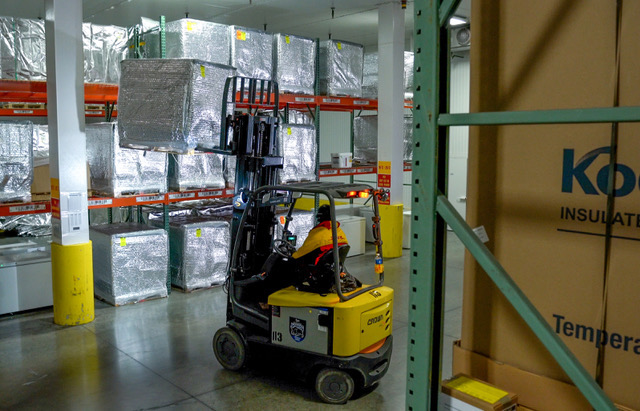Costs and risks could dampen marketplace supply response.
Much has been made of the cold-chain infrastructure required to store and distribute the COVID-19 vaccines. But the demand for cold-chain capacity was growing before the pandemic hit, and the pharmaceuticals segment was a growing, although still small, part of cold-chain demand.
This vulnerability is underscored by the fact that the average age of cold-storage warehouses in the United States is 42 years, according to a recent report from the global real-estate firm JLL, and that “much of that inventory is aging and rapidly approaching functional obsolescence.” The national vacancy rate of cold-storage facilities sits below 10%, all of which would suggest that demand for new pharmaceuticals cold-storage space should be on the rise.

Obstacles to Development
But developing the supply to meet that demand faces a few obstacles. New temperature-controlled warehouses are expensive to build, costing twice as much as their conventional counterparts, according to JLL: up to $180 a square foot for temperature-controlled warehouses versus $70 to $90 per square foot for conventional warehouses. JLL projects that construction costs will increase along with demand, which accounts for the reluctance of developers to build cold-storage facilities on spec; that in turn, puts the continued squeeze on supply.
If the uptick in demand for cold-storage space will embolden some developers to try their hand at speculative construction, then the lion’s share of that demand will come from food companies and retailers. “Pharmaceutical cold storage is a very small subset of the overall industrial cold storage sector,” noted a recent report from CBRE Research, “so the investment opportunity will naturally also be rather limited.” Also, “pharmaceutical companies require cold storage conditions that are more precise than those for most food products,” so pharma will not want to piggyback on cold-storage space designed for food.
The size of pharmaceuticals cold-storage facilities typically range between 20,000 and 60,000 square feet, noted CBRE, much smaller in scale than traditional cold-storage warehouses, which usually encompass 150,000 to 400,000 square feet. All of these facts highlight why potential developers of pharma cold-storage space are concerned about construction and operating costs.
In connection with costs, it’s interesting to note where some leading supply-chain providers have located their pharma cold-storage presences. In May, DB Schenker Americas announced it had expanded its existing Indianapolis logistics facility to include an additional 5,000 square-foot cold room and 50,000 square feet of controlled room-temperature space, more than doubling the temperature-controlled areas at the facility. Indianapolis, by no coincidence home to the pharmaceuticals giant Eli Lilly, has hosted the Schenker facility since 2006.
Besides its proximity to Lilly, the Indianapolis location allows DB Schenker to leverage the less-congested Indianapolis airport, noted Benjamin Zervas, DB Schenker Americas’ head of healthcare airfreight management. “As the major airports in the U.S. become more congested, smaller airports like Indianapolis have become more suitable for moving temperature-controlled healthcare shipments,” he said. “We can move directly from the tarmac to our facility, reducing any risks of temperature deviation during operations.” Schenker flies to and from Indianapolis and Luxembourg, another important pharmaceuticals center, on flights with dedicated temperature-controlled capacity.
In 2019, before the pandemic hit, DHL Supply Chain developed a new pharmaceuticals distribution site in Indianapolis. That was part of a $150 million, 40% expansion of its pharmaceuticals network in the U.S., which also included another new site in Raleigh, N.C.
Location Matters
When it comes to the pharmaceuticals cold chain, “location matters,” noted a recent report from the Council of Supply Chain Management Professionals (CSCMP). In contrast to groceries, which require facilities in populated areas, the report said, “the opportunity for pharmacy cold storage can often lie closer to the sites of major pharmaceutical manufacturers and life science research centers.”
That’s one reason why DB Schenker and DHL both invested in Indianapolis, and why DHL invested in North Carolina: its new facility is close to the Raleigh-Durham Research Triangle, the fastest-growing area in the U.S. for pharmaceuticals production. Not surprisingly, Indianapolis and North Carolina are both “places to watch” for new pharmaceuticals supply-chain investments, according to John Boyd, principal of The Boyd Company, a New Jersey-based corporate site-selection consultancy.
Rocky Mount, North Carolina, 60 miles from Raleigh, has attracted the attention of developers of late, according to Boyd. Besides being close to the Research Triangle, Rocky Mount is situated along the I-95 corridor, providing access to major East-Coast markets from Boston to Miami.
The location factor and the cost factor, it turns out, are closely related. A study by Boyd showed that the annual operating costs of a 175,000 square-foot pharmaceuticals supply-chain distribution center in Rocky Mount would be 34% lower than in Staten Island, N.Y., 25% lower than in central New Jersey, and 23% lower than in Nashua, N.H.

Location matters, also, when it comes to the energy costs of pharmaceuticals cold-storage facilities. “Developers look at utility prices,” said Boyd, “which vary significantly throughout North America.” Indiana, with an average of 12.02 cents per kilowatt-hour and North Carolina, at 11.24 cents, are both well below the U.S. average for electricity prices of 13.13 cents, according to data from the U.S. Energy Information Administration.
Pharmaceuticals cold-chain investments may be getting a closer look from developers, but, despite increasing demand, it’s not realistic to expect an all-out boom in new speculative construction anytime soon. “For many, it will be their first development of this type of product,” the CBRE report noted, “finding themselves in a place to learn about the cold chain, the industry, and the ramifications of the risk involved,” perhaps the hard way.
The market analysis for these types of projects, the report added, “when done properly, is complex and exhaustive.” Cold storage facilities, the report concluded, are costly to build, offer returns “slightly less” than ordinary warehouses, and, importantly, “the risks are higher.”





